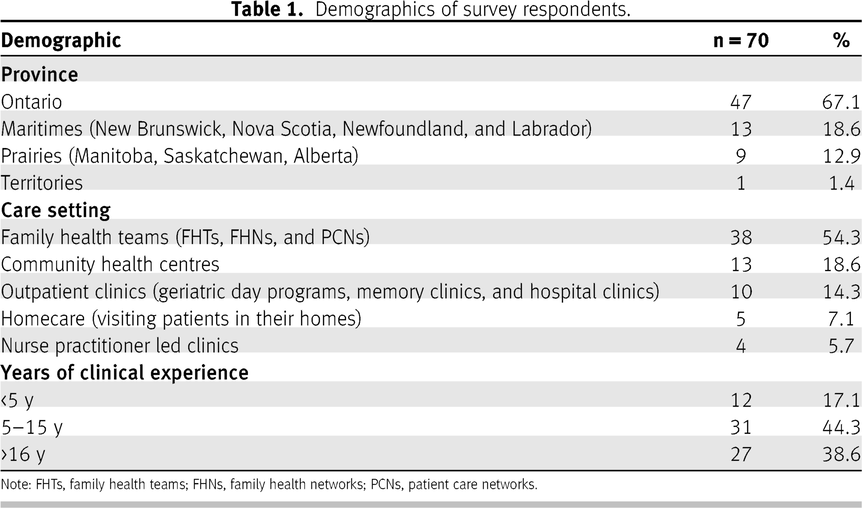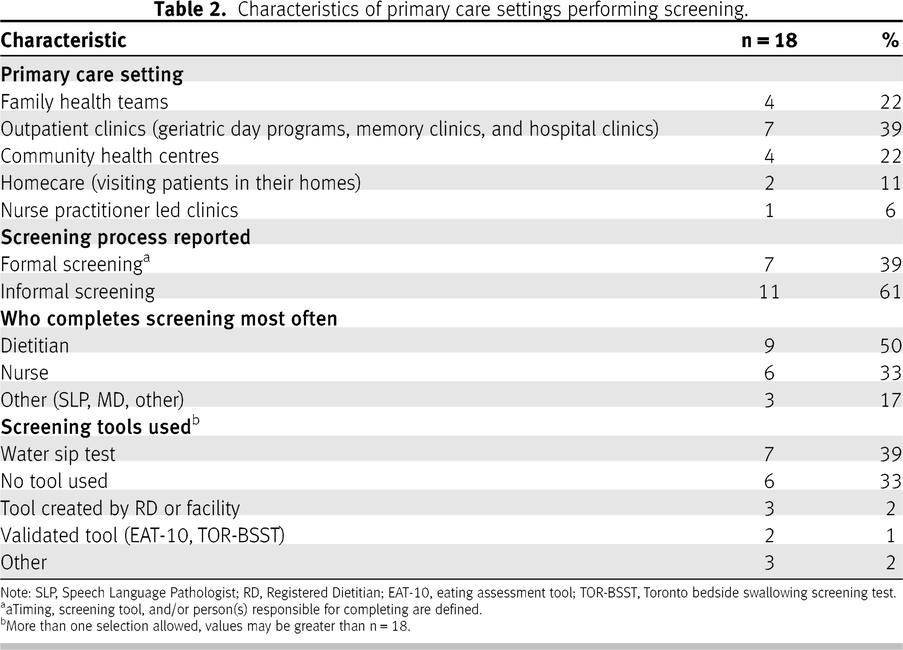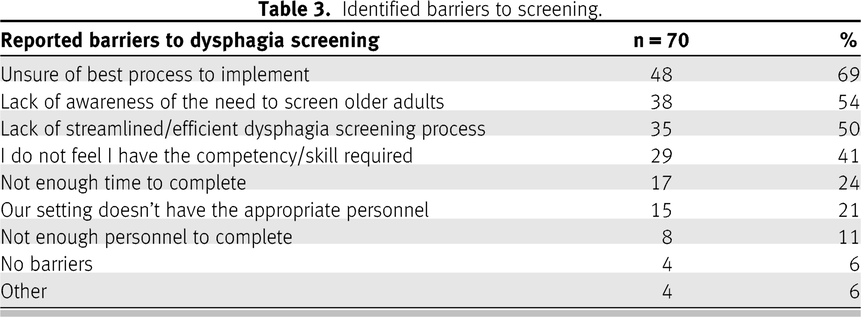INTRODUCTION
Dysphagia, or difficulty swallowing, is a significant risk factor for aspiration, respiratory infections [
1,
2], and malnutrition [
1,
3–
6]. In Canada, malnutrition accounts for $2 billion per year in health care costs [
7]. Globally, malnutrition causes longer hospital stays, high re-admission, and in-hospital mortality rates [
8–
12]. Dysphagia affects up to 35% of older adults living in the community [
1,
13–
16] and approximately 50% of hospitalized older adults [
1–
3], impacting not only nutrition and hydration status but medication intake and overall quality-of-life [
17–
19]. Despite the prevalence of swallowing issues reported in the community, a workforce survey of 450 dietitians working in Ontario primary care family practice reported very few referrals for nutrition counselling for dysphagia assessment or management [
20]. Both under-identification of dysphagia [
4,
14,
15] and lack of conversations about swallowing concerns [
14] with patients have been previously reported and may provide an explanation of the low referral rates for nutrition counselling within family practice.
Early identification and intervention is important to minimize the risks of unmanaged dysphagia [
21–
25]; however, little is known about dysphagia practices of dietitians in Canadian primary care. The aim of this study was to learn more about the dysphagia identification and assessment practices of dietitians working in primary care in Canada, identify gaps in practice, and inform future team-based care initiatives.
METHODS
An original 17-question, online survey of dysphagia identification, assessment, and management practices was developed by the research team. This was completed in consultation with both existing literature and a panel of dietitians with experience in practice-based survey research design, primary care dietetics, or dysphagia management [
20,
26,
27]. Content validity was confirmed through survey pilot, post-pilot questionnaire, and consultation with experts to ensure the questions were interpreted as intended and the survey was comprehensive, relevant, and would accurately reflect the Canadian primary care setting. Feedback was incorporated to refine the questionnaire, which in its final form consisted of 12 nominal, 3 interval scale, and 2 open-ended questions (including 3 demographic questions) (see
Supplementary File1) and took approximately 10 minutes to complete. Registered dietitians were eligible to participate if they practiced >50% of their time in direct nutrition care in primary care. Primary care was defined as family physician offices, family health teams (FHT), community health centres, family health networks (FHN), patient care networks (PCN), nurse practitioner led clinics, homecare, centre local de services communautaires, retail settings (grocery stores), and geriatric day programs. Invitations to participate were distributed through Dietitians of Canada (DC) networks and newsletters as well as email distribution by consenting provincial dietetic regulatory bodies. A second invitation was distributed through DC newsletters. The survey was administered in both English and French by Canadian Viewpoint, an independent provider of market research. Descriptive analyses were conducted using Stata software (StataCorp LLC. Release 15, TX, 2017). Informed consent was assumed by completing the survey. This study was reviewed by the Hamilton Integrated Research Ethics Board in Hamilton, Ontario.
RESULTS
Respondents
Across the country, 70 surveys were completed by dietitians working >50% of their time in direct patient care in primary care settings (
Table 1). Respondents were primarily from Ontario (67%, 47/70) with approximately 55% (38/70) practicing in “family doctor’s office” settings (FHTs, FHNs, and PCNs). The majority of participants reported 5 or more years’ experience as a clinical dietitian (83%, 58/70).
Dysphagia screening
Approximately 75% (52/70) of dietitians do not use a dysphagia screening protocol of any kind in their work setting. Of the 18 dietitians who reported having a screening process, 39% (7/18) worked in outpatient clinics, 61% (11/18) reported an informal dysphagia screening process, and 50% (9/18) reported dietitians completed the screenings most often (
Table 2). Thirty-nine percent (7/18) use a water sip test to screen, approximately 33% (6/18) do not use any screening tool, and nearly 17% (3/18) are using a tool they created themselves.
Over 85% (60/70) reported identifying 5 or less individuals with possible dysphagia over the past 3 months, and 31% (22/70) reported zero patients were identified. Frequently identified barriers to screening included “unsure of the best dysphagia screening process” (69%), “lack of awareness of the need to screen older adults for dysphagia” (54%), and “I do not feel I have the competency or skill required to complete dysphagia screening” (41%) (
Table 3).
Dysphagia assessment
Once a potential swallowing problem has been identified, 60% (42/70) reported the next step is a referral to a speech language pathologist (SLP) for a formal swallowing assessment. Eight percent (6/70) reported the next step as a noninstrumental, clinical swallowing assessment (CSA) completed by the dietitian. The 2 most common barriers to performing CSA were reportedly lack of competency or skills to complete CSA (67%, 47/70) and insufficient personnel and resources (26%, 18/70). Approximately 26% (18/70) were either “not sure” or “did not believe” CSA fell within their scope of practice. Over 70% (51/70) reported needing hands-on dysphagia assessment training.
Dietitian referrals and perceived prevalence of dysphagia
The majority of respondents (87%, 61/70) had less than 6 referrals for dysphagia education and management in the past 3 months, whereas 34% reported receiving no referrals in the same time period. Across all primary care settings, the mean reported prevalence of dysphagia was 15% (n = 70), lower than reported prevalence in homecare (29%, n = 5) and geriatric programs (57%, n = 3).
Tools and training
Over 85% (60/70) of respondents would like validated screening tools to identify dysphagia in daily practice and 70% (50/70) would like hands-on training for dysphagia screening and assessment and tools to share with their teams to raise dysphagia awareness in primary care. Another 60% desired other tools including interprofessional clinical care pathways, patient–caregiver resources, and custom electronic medical record forms to standardize assessment and documentation.
DISCUSSION
Despite the relatively high prevalence of dysphagia previously reported in community-dwelling adults [
14,
16], results of this survey of dietitians working in Canadian primary care suggest dysphagia is under-recognized. Nearly three-quarters of respondents do not have a dysphagia screening protocol of any kind. Clinical swallowing assessments are being completed by a very small number of respondents after a swallowing issue is identified, and dietitian referrals for dysphagia education and management after diagnosis were likewise surprisingly low. Dietitian referrals averaged < 6 per month for most respondents and zero referrals for one-third of them. This low referral rate for dysphagia nutrition counselling aligns with the results of the 2015 workforce survey of dietitians working in primary care family practice teams in Ontario that also identified a care gap for patients at risk of dysphagia [
20].
Given the prevalence of common health conditions often related to increased dysphagia risk, including respiratory conditions, neuromuscular conditions, history of stroke, dementia, dental issues, and medications impacting swallowing abilities, it’s surprising to see such low numbers of individuals with dysphagia being identified in primary care [
28–
31]. Lack of awareness of the prevalence of dysphagia in primary care and lack of a standardized screening and assessment protocol may explain the low referral rates and current underidentification of dysphagia in this setting. Individuals with swallowing concerns represent a vulnerable population that may not be fully benefiting from primary care dietetic services available.
In a 2007 waiting room survey of primary care adult patients in Augusta, Georgia (n = 947), 22% reported symptoms of dysphagia, yet less than half (46%) discussed their symptoms with their family physician [
14]. Symptom severity, frequency and duration, and impingement on social activities appear to influence patient decisions to discuss swallowing issues with their physicians. Instead of waiting for the patient to report symptoms, the authors advocate for clinicians to prompt the discussion by asking, “Do you have trouble swallowing?” [
14]. Asking about swallowing and using validated screening tools can enhance detection, lead to more timely intervention, and reduce the risk for negative consequences of undetected dysphagia such as malnutrition and respiratory infections [
1,
5,
10,
23]. In this study, only 11% reported using screening tools validated for primary care, such as the Eating Assessment Tool (EAT-10) or Toronto Bedside Swallowing Screening Test (TOR-BSST) [
32,
33].
Once a potential swallowing issue has been identified, further assessment is needed to understand the structural and functional impairments in swallowing function and to outline a management plan for the patient. If oral intake is tolerated, patients can be educated on how to adjust foods and fluids accordingly to help improve swallowing safety and efficiency. As SLP services are not typically available in primary care, access to timely dietitian-led clinical swallowing assessments could help expedite a management plan and help minimize the consequences of unmanaged dysphagia [
34]. The high percentage of dietitians who identified lacking the competency or skill required to complete dysphagia assessments endorses the need for further education in this area. More importantly, nearly one-third were unaware clinical swallowing assessments fall within the dietetic scope of practice with appropriate training. One of the first steps in improving dysphagia screening and assessment practices by dietitians in primary care is to ensure dietitians know their scope of practice in the province where they practice [
34–
36].
Dietitians working in primary care who completed our survey would like additional education and practice tools to feel more confident identifying, assessing, and managing dysphagia. Educational workshops for dietitians on dysphagia identification and management are available from professional associations such as DC. These could help dietitians achieve and maintain competency in this area [
37]; however, primary care dietitians may not be accessing them, potentially due to lack of resources and/or education time. The creation of screening programs using validated tools were of particular interest, as were advocacy tools to raise awareness of dysphagia in primary care including clinical care pathways outlining team involvement in dysphagia assessment and management.
Limitations
This survey of 70 dietitians provides a snapshot of dysphagia identification and assessment in primary care across Canada and underscores the perceived lack of competency and skills and potential need for further training in this area. A response rate was not calculated as the extent of survey distribution is not known; however, considering Ontario has approximately 500 primary care dietitians, the response rate appears low. This may limit the generalizability of our results. Relying on provincial dietetic regulatory bodies to distribute the survey link to their membership was a challenge as many declined to participate. As noted in this study, many dietitians identified the need for more education in dysphagia, and it is plausible a lack of confidence in their knowledge may have impacted their desire to participate in this dysphagia practice-based survey. Finally, lack of an incentive to complete the survey and members only access to the DC advertisement could explain the challenges accessing and recruiting dietitians working in primary care for participation.
In conclusion, dysphagia is a significant risk factor for malnutrition and efforts are needed to identify patients at risk in primary care where early detection and intervention may reduce complications and hospital admissions. Dysphagia is prevalent in primary care yet our survey identified dysphagia screening is only occurring in one-quarter of primary health care settings, and nutrition referrals for dysphagia counselling are extremely low. Those who are screening are primarily using screening methods not validated for the primary care setting.
RELEVANCE TO PRACTICE
Additional training and education may be needed to ensure dietitians know their scope of practice and develop competency in dysphagia identification and assessment. Initiatives to increase the awareness of the necessity for dysphagia screening and access to screening processes for primary care could help improve early identification of dysphagia. Forming a mentorship program for hands-on training and dysphagia tool kits including validated screening tools, and clear primary care clinical pathways could help identify those at risk and expedite access to dysphagia management services. Ensuring dietitians know their scope of practice and are competent to perform clinical swallowing assessments would improve access to dysphagia care for primary care patients. Dietitians have a leadership role to play in primary care to raise awareness of dysphagia within their teams, to advocate for the use of validated screening tools and best practices for team-based care, and to ensure patients with dysphagia can access appropriate management strategies in a timely manner.
Financial support: Funding for the development, distribution, and analysis of this quality improvement study was provided by Nestlé Health Science.
Conflicts of interest: MMW received funding to support this work. CS is an employee of Nestlé Health Science.






